SEO Outreach - Ultimate Guide
In this blog, I will show you how EXACTLY I do my SEO outreach (or link outreach or backlink outreach).
I will demonstrate different techniques and tools, which helped me to get many good quality backlinks.
Outreach is the fundamental of any successful SEO campaign.
Outreach is the key strategy to get high-quality backlinks to your site. And high-quality referring domains are the key to growing organic traffic.
Why backlinks matter?
If you are advanced in SEO, just skip this paragraph 😀
There are three most important elements of any SEO strategy, I call them “3 Whales of SEO” 😀:
- Backlinks;
- Keyword research;
- Content (based on keywords).
Backlinks + Keywords research + Content = Perfect SEO Strategy
If you remove any of these whales, your SEO earth will crash.
E.g. if you have strong domain authority and amazing content, BUT your content is not adjusted to a keyword group – you won’t get a lot of traffic from Google.
If you did keyword research and have a strong domain, but the content is poor – you won’t get any traffic either. And of course, if your site features high-quality content, based on keyword groups, BUT there is a low number of referring domains pointing to your site – don’t hope for any good Google traffic.
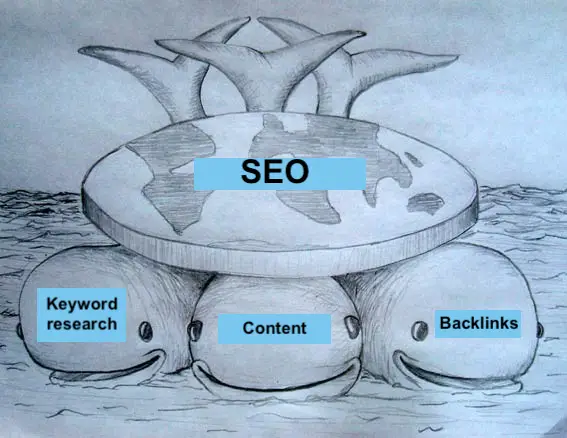
And here is a Google Analytics screenshot, from one of my projects, where I reached 100K sessions per month (in about 15 months). This is a 100% free traffic, with 85%+ coming from Google organic. With active link building and outreach.

And here is a screenshot from another project (only organic traffic, in a span of a year) – with good quality content, but no link building, no outreach. There is some growth, but this is not what you are aiming for after a year of hard work.

So, high-quality backlinks pointing to your site matter A LOT.
Outreach – best way to get backlinks
How do you get backlinks?
There are hundreds of ways to get backlinks, including:
- directories
- PR
- local listings
- social media
- guest posts
- mentions
- outreach
- link exchanges
- competitors research
- links from customers
- comments
- links in forums,
- etc, etc.
On Fiverr, you can find hundreds of $5 gigs, which offer 10-10000+ instant backlinks. These types of links can actually harm your site.
The best backlinks are those, which people actually click, on high authority, relevant sites in your niche.
And outreach is one of the most effective ways to get good quality backlinks.
SEO outreach – reaching out to similar sites in your niche, asking either for a backlink, guest post, collaboration, mention on social media or all together.
You create these kinds of high-quality links by establishing connections and relationships with influencers, bloggers and site owners.
And it is hard work. That’s why many SEO agencies and tools can easily charge you $100-$500 for one backlink. I have seen offers from middle-range agencies for $2000-3000 per month when they place 3-5 medium quality backlinks on niche sites (not Forbes or Entrepreneur.com).
I get high-quality links with Outreach, mainly with these two ways:
- by asking to mention my blog post on their site;
- by asking for a guest post.
Outreach Templates
Your outreach emails can look similar to this:
Hey, I stumbled your great blog about [link to target blog]. Great job!
Recently, I created something similar: [link to your blog]
Would you mind checking it out and maybe, linking in your blog or sharing on social? Thanks!
Cheers,
[Your Name].
You may laugh, but it works! This super simple outreach created lots of high-quality backlinks to my blogs.
Or you can ask for a guest post.
Hello Team,
I stumbled your cool blog [link to target site] and was curious if I can provide you with some guest posts?
My blog – [link to your blog] – covers mainly [explain your niche].
For example, check out my post about … [link to your cool blog post]
Currently, I have these topics in mind, which I can bring you (1000+ words):
– topic 1
– topic 2
– topic 3
Would you be interested in this or any other content, relevant to [your niche]?
I will include one link to [link to your blog] in the bio section.
Looking forward to your reply.
Andrew.
You need to add at least one or two followup emails – they do the work.
Of course, there are many other templates you can try. Also, test email headlines, experiment with many tactics.
So, below I will go through the main tools and tactics I use for outreach.
In my experience, these are some of the main problems with SEO outreach:
- how to quickly export emails from sites;
- how to send bulk email;
- how to automatically send follow-ups.
Manual Outreach: Email Extractor + Gmail (free)
If you don’t run a big blog or just starting out – you can try to do outreach manually.
I started like that as well.
To extract emails you can use free Email Extractor Chrome extension.

This is how it works: if there is an email on a webpage, it will be added to the extension. The downside is that, if the email is on some other page – this extension won’t capture it.
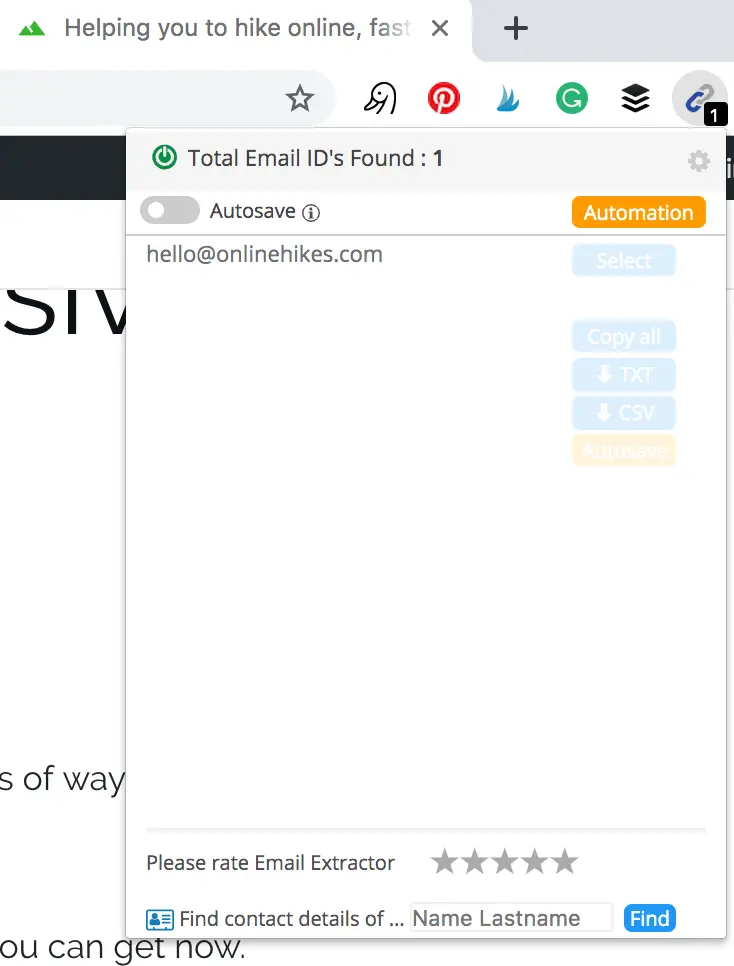
If you upgrade, this extension can autosave emails.
After that, you can use a standard Gmail account and send emails. For beginners, you can use the BCC option. This way you can send bulk emails in Gmail, without other users noticing it – of course, it is not the best option, but it does the job.
The downside – you can’t set up follow up emails or sequences. And followups are key with outreach.
So, you can upgrade to something like Gmass or Mailshake.
Pros
It is free.
Cons
Time-consuming.
Non-scalable.
No automated follow-ups.
Hunter.io + Mailshake ($49+$29 per month)
Hunter.io is a great email extraction tool. You get 100 free credits (email extracts) for free. It’s $49 for 1000 emails.
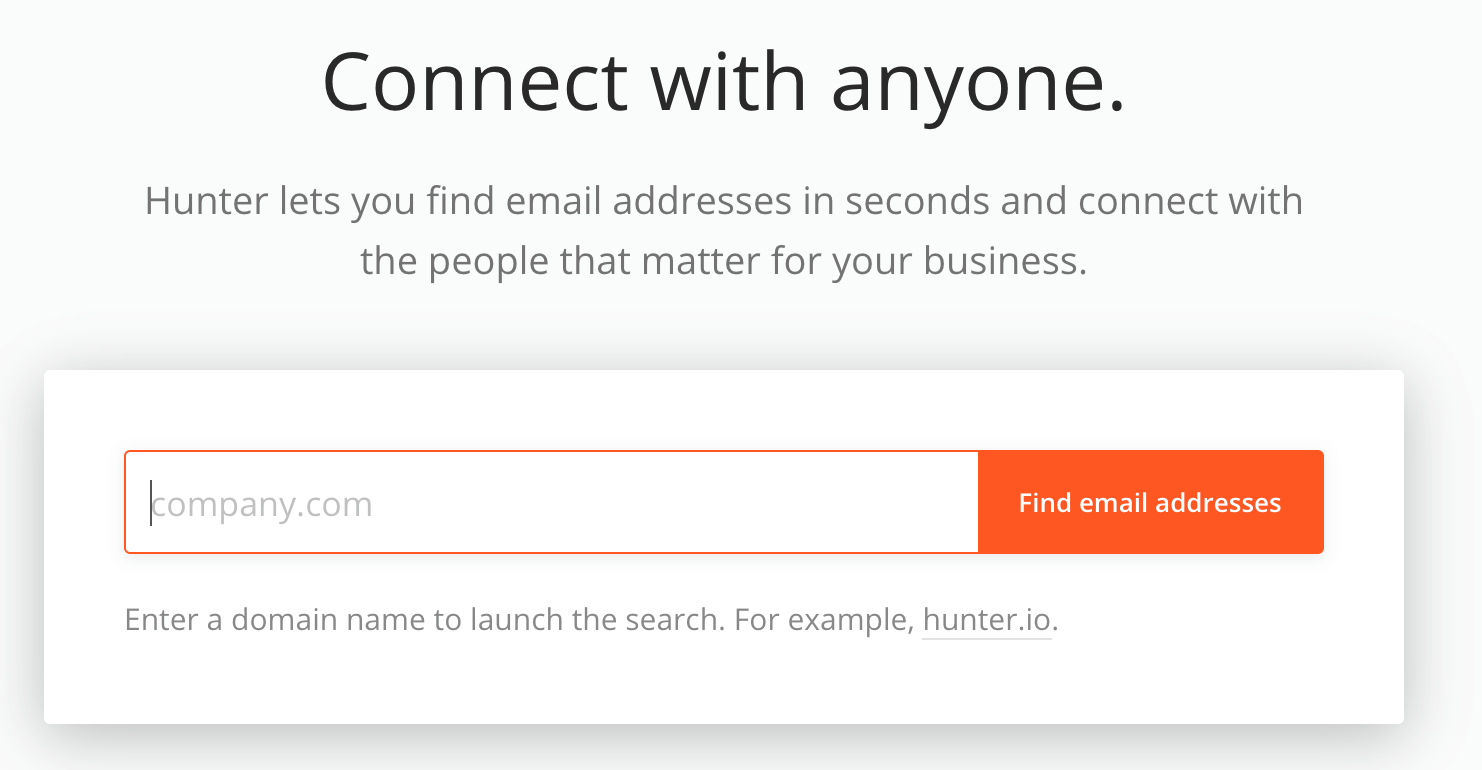
I just import a list of websites into hunter.io and get a list of emails in CSV file.
After that, I can use Mailshake – best cold email outreach software ever.
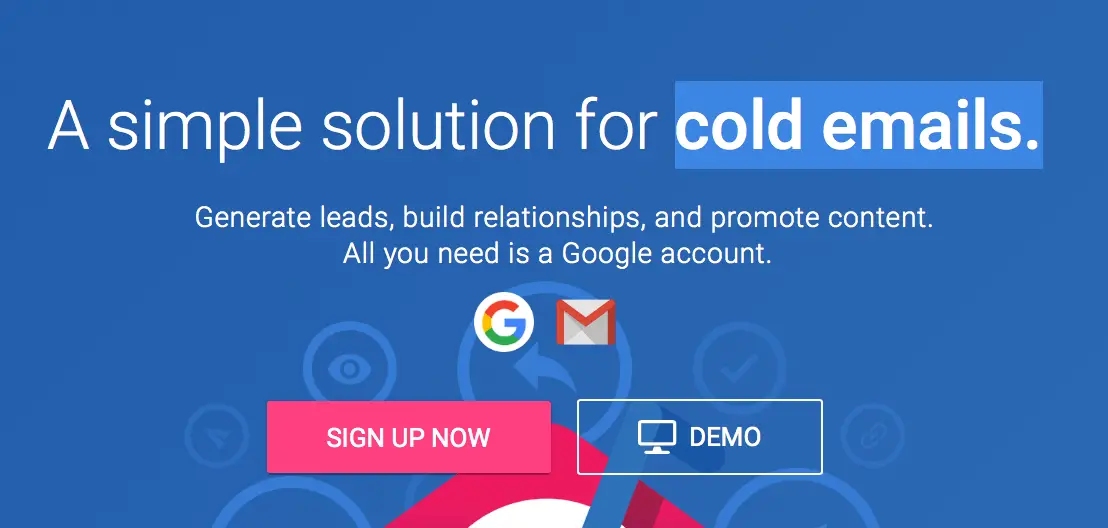
After you import your emails to Mailshake, you can create a campaign with follow up emails.
Here is how a campaign dashboard looks like in Mailshake.

Here is an example of my Guest post sequence in Mailshake.
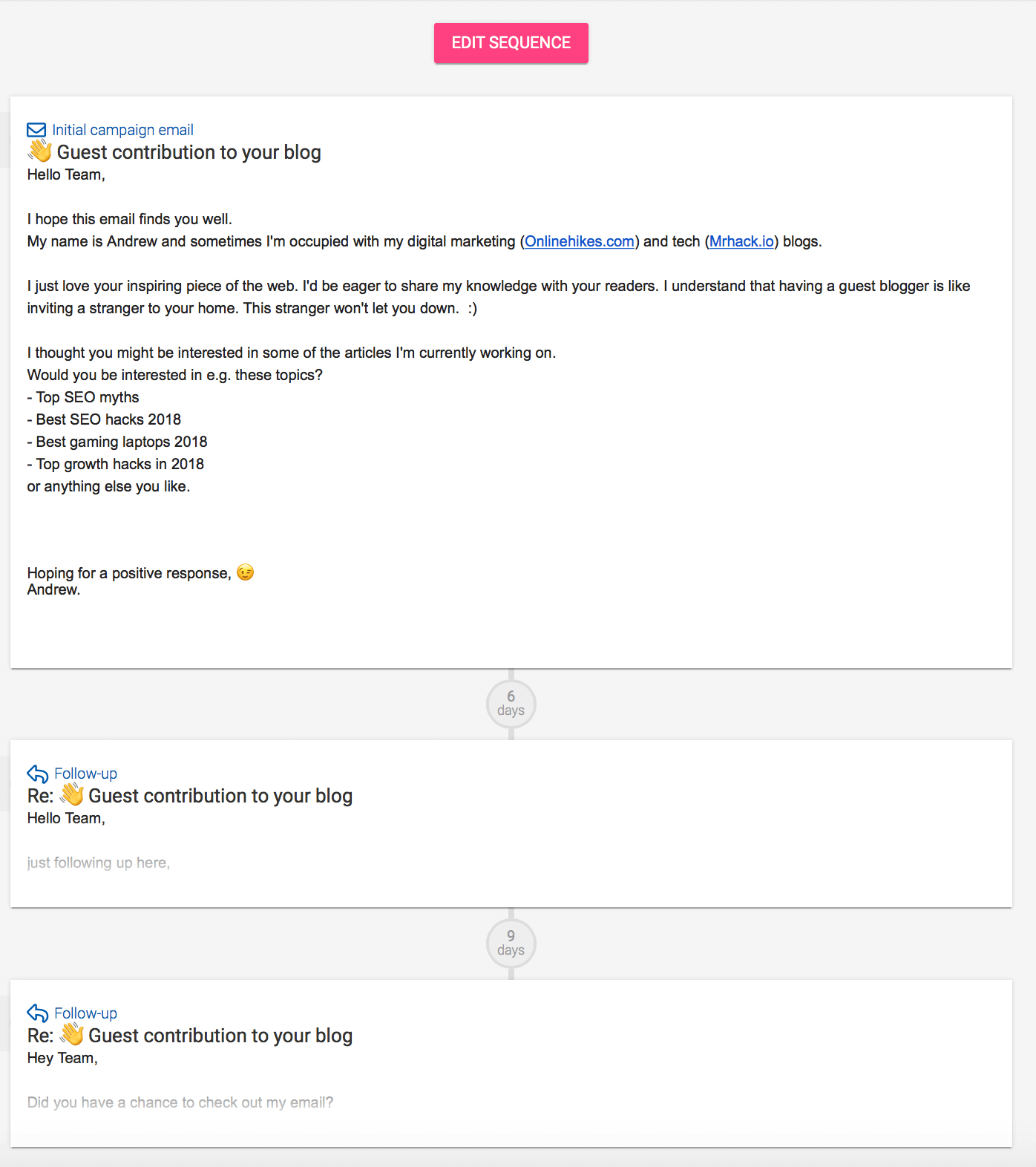
Pros
An export large number of emails.
Easily send bulk emails.
The best option for large campaigns – hundreds and thousands of emails.
Cons
Price.
You need to use separate tools – not the best experience.
Outreach with Buzzstream ($24 per month)
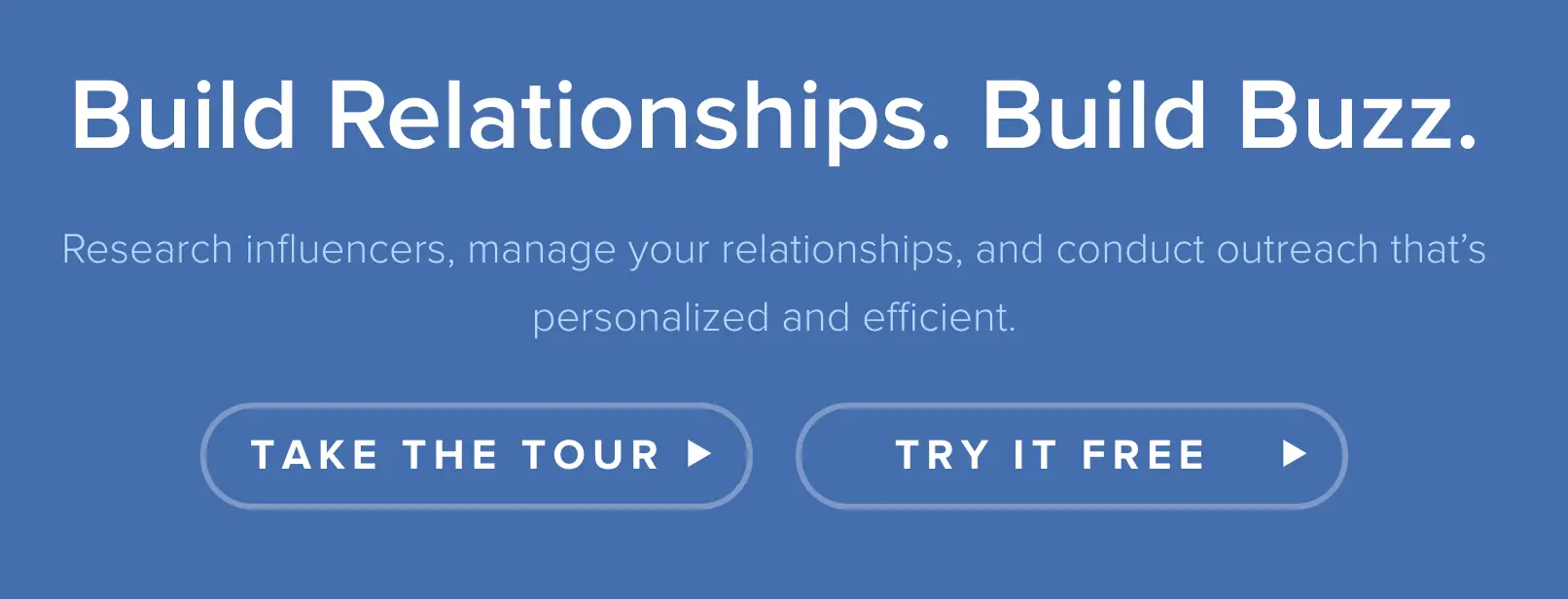
For me, Buzzstream solves the main problems with Outreach:
- extracting contact information from sites (email, social media, contact page URL, etc)
- sending emails
- adding followups (via sequence)
- bulk sending emails
- collecting influencers in one place
- influencer research
- and many more.
Buzzstream menu has 5 items: websites, people, link monitoring, dashboard and reports.
Here is how the Buzzstream dashboard looks like.
It looks like an email client, with all emails you sent to different sites.

So, for a start, you need to create a new project.
Click on “All contacts” -> New project.

In the next popup, you can customize which members to include in the project, either to enable link monitoring and to send backlink reports.
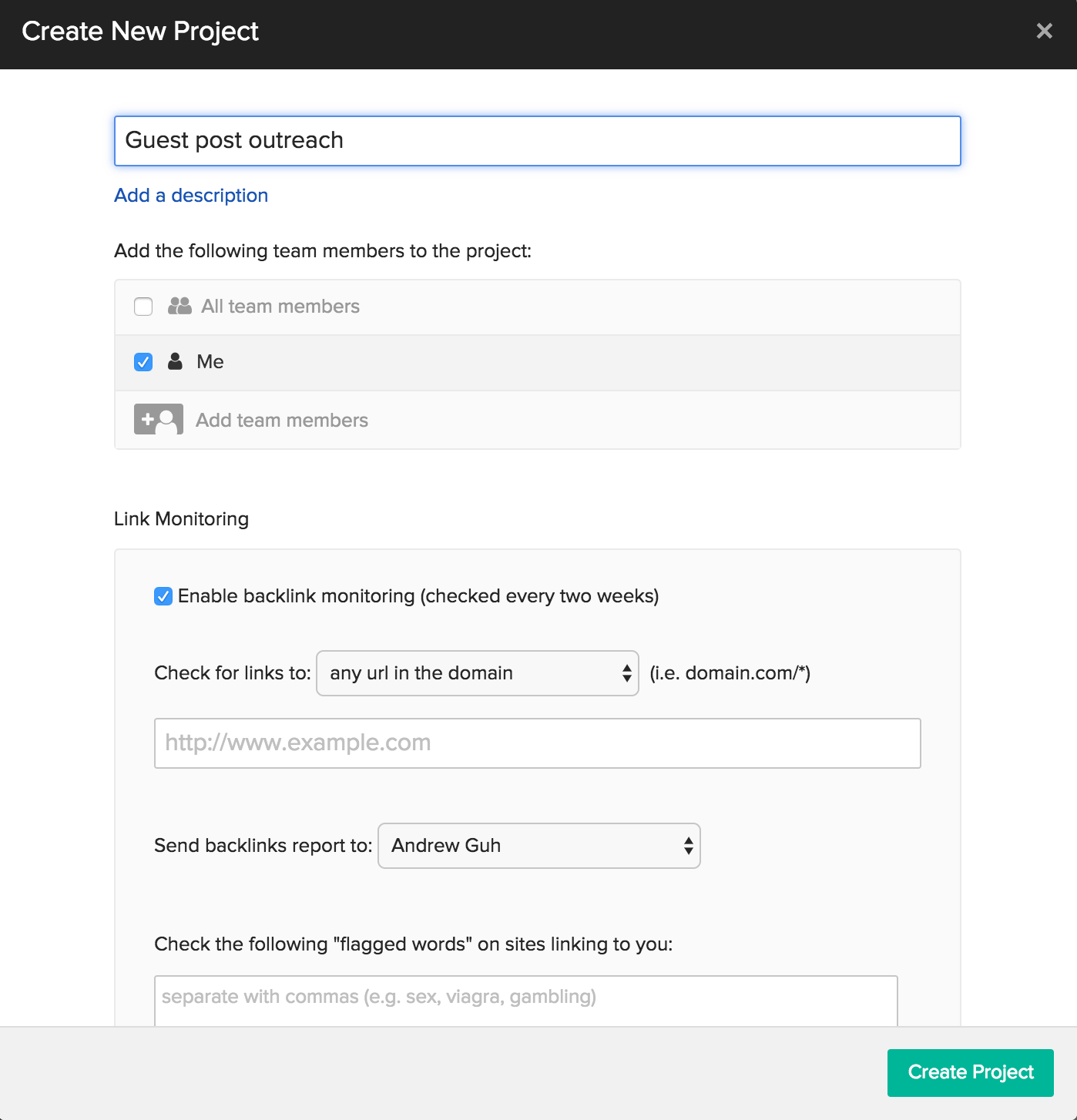
After that, you need to add a list of websites to the project.
In Buzzstream, you can add websites in three ways:
- via Discovery tool (find top influencers in your niche)
- via Buzzmaker extension
- add websites manually

I prefer using Buzzmaker extension (will explain below) or adding a list of websites manually.
So, if you are adding websites manually, you can either copy paste them or import as a CSV file.
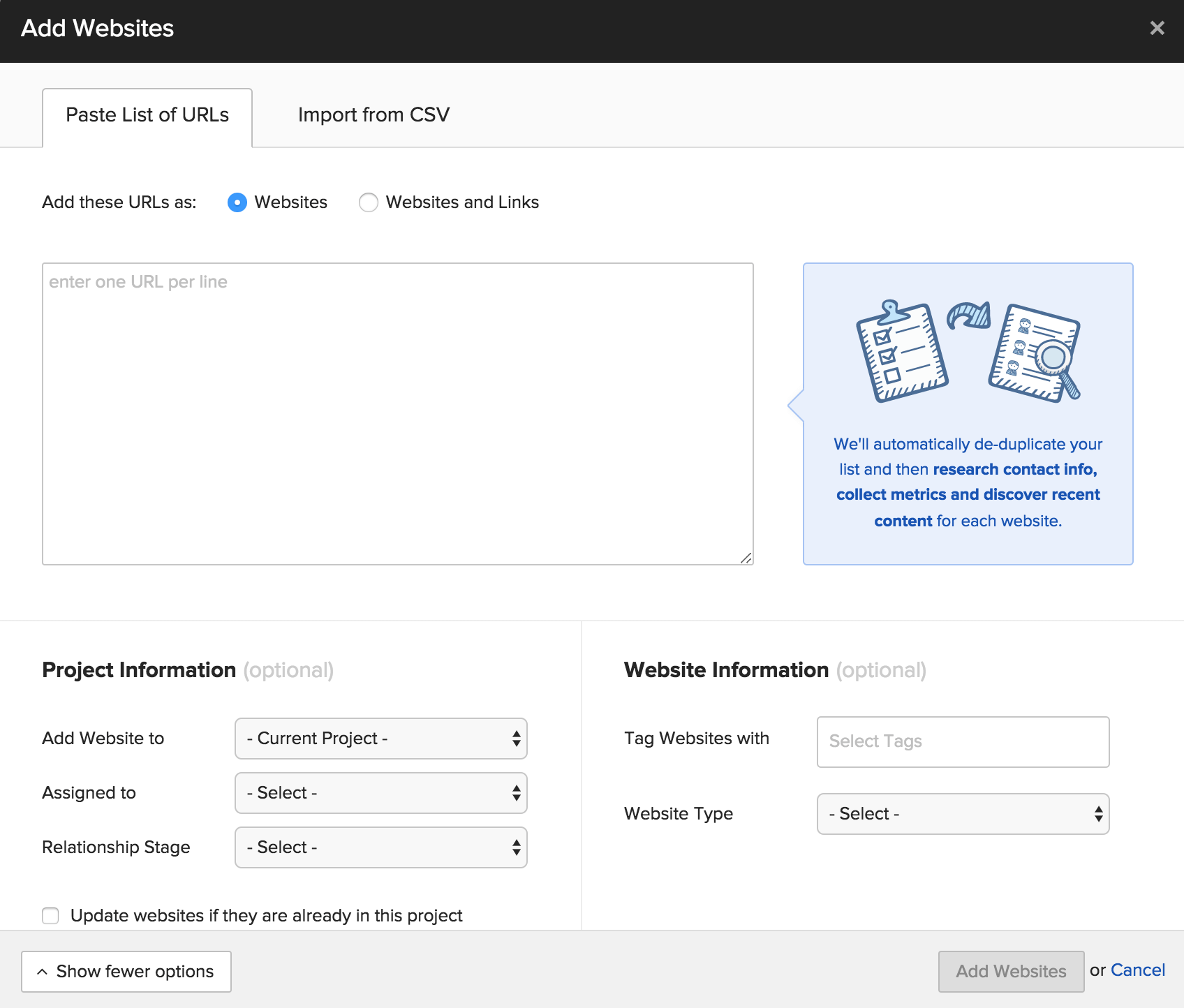
There are different ways to collect lists of target websites.
Sometimes, I use some scraper software – e.g. free Oscraper extension – and scrape 100 websites from SERP. After that, I will have a nice list of 100 sites – ready to be added to Buzzstream.
My preferred way to collect websites is with Buzzmaker extension.
Buzzmaker – Buzzstream Chrome extension
Buzzstream has a handy Chrome extension – Buzzmaker.

For example, I just wrote a blog about SEO guide. I want to find similar blog posts in Google and ask them to include a link to my blog.
With Buzzmaker extension, you can easily add all sites from SERP to your Buzzstream project.
Just type a required search query in Google search.

FYI: search queries (or footprints) you type in Google search box, can be a massive tool. For example, to find suitable sites for guest posts, you can use:
- Keyword “guest post”
- Keyword intitle:“write for us”
- Keyword inurl:”write for us”
- Keyword “submit a guest post”
- Keyword “submit” AROUND(4) “guest post”
- Keyword “guest post by”
- Keyword “accepting guest posts”
- Keyword “guest post guidelines”
After you added websites, Buzzstream will export contact information.
You will see:
- Discovered contact information
- Domain authority (if site worth pursuing?)
- Post frequency
- Overall rating
- Other custom fields.

After that, I sort discovered contacts by E-mail (just by clicking on the menu) and start with E-mail outreach.
Now you need to create a Sequence.
Sequence or follow up emails are really effective with outreach. Usually, I send 2 follow-ups: 4 and 7 days after the previous email, if there is no reply.
Here is an example of one of my Sequences for SEO guest posts.
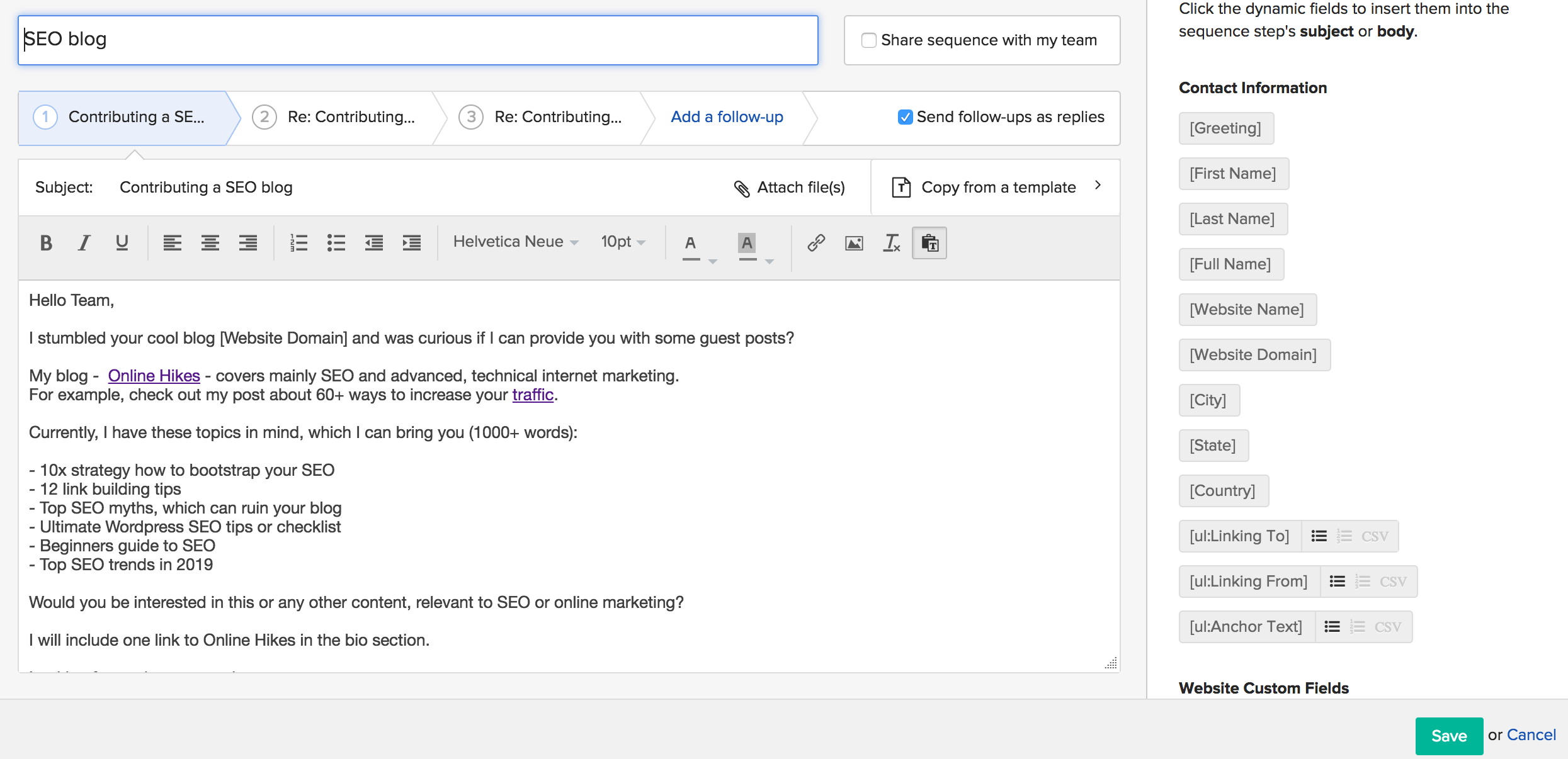
With Buzzstream you can easily customize and save templates and sequences, add them to different projects, share with different members, etc.
After your Sequence is ready, it is time to start outreach.
Select required sites and click “Outreach” and “Send individually” or “Bulk send” (available with more expensive plan).
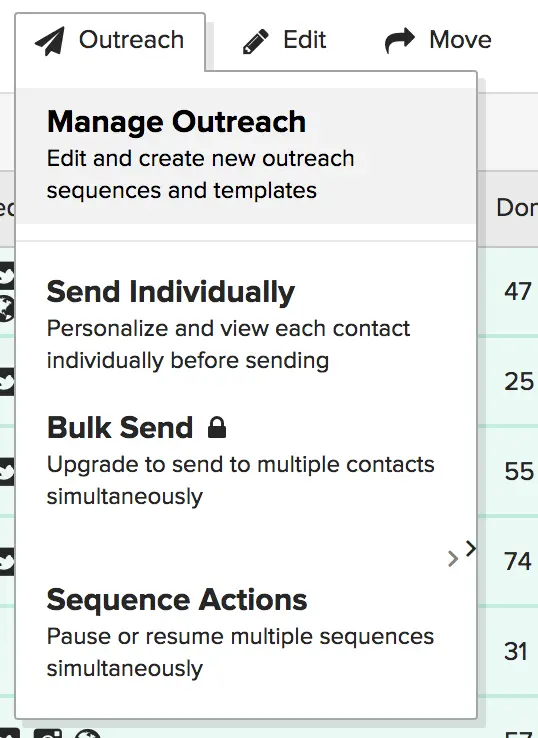
Here is how your Outreach process can look like.
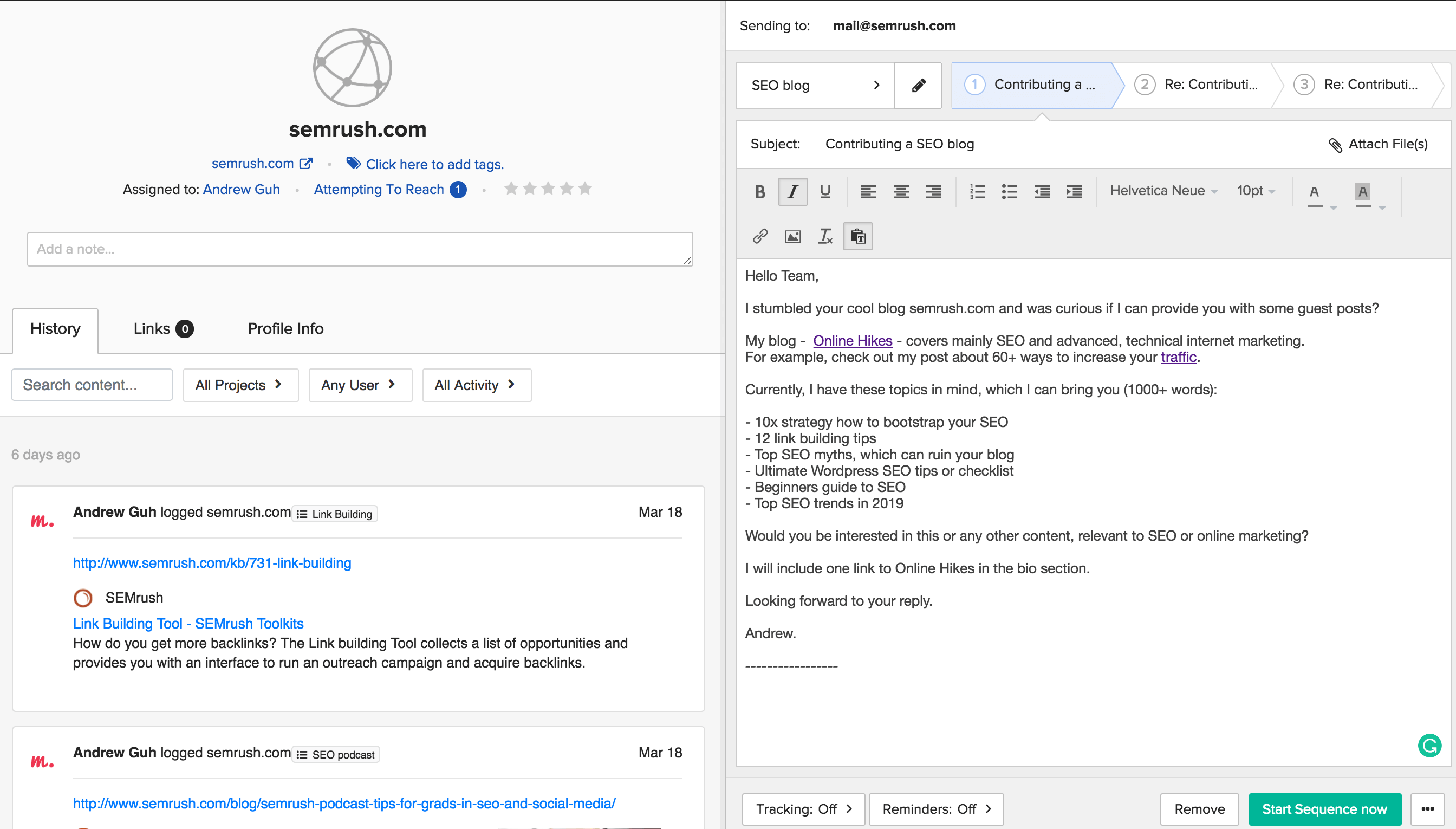
It is important to select personal email, personalize your template and try not to spam. I usually send 50-80 emails per outreach campaign.
If email is not available, try to reach via a contact form. Buzzstream discovers URLs of these pages. In my experience, I have a pretty high response rate from contact forms.
If you have big lists and many contacts, it can be a good idea to outsource this process to a VA.
After you are finished with E-mail outreach, continue with Social outreach.
Buzzstream gets all social media handles.
Tweet to your contacts, message them on Facebook, @mention influencers in your posts.
Buzzstream Outreach Template
So, in short, you have to do these steps:
- Create a new project
- Add new sites (either manually or via extension)
- Create E-mail template and sequence (with 2-3 follow-ups)
- Start E-mail outreach
- Do social media outreach (Twitter, Facebook)
- Outreach via the Contact page (if no E-mail).
Here is a pricing structure for Buzzstream.
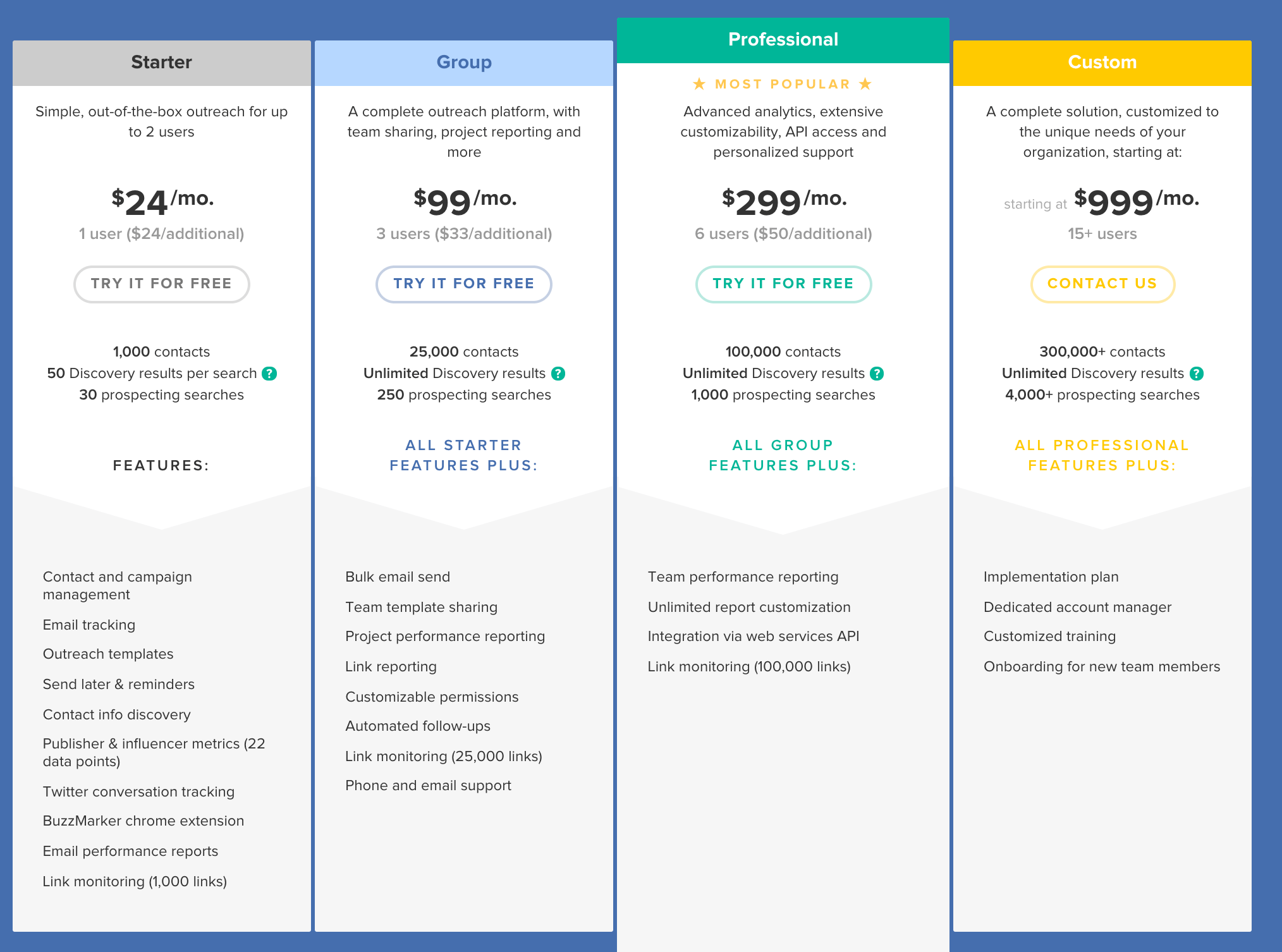
So, what are the pros and cons of Buzzstream?
Pros
Easily extract emails
Send followups
Keep contacts
Everything in one tool
It’s cheap – $24
Cons
Bulk send doesn’t work well – often you need to send emails one by one
Buzzstream can get expensive for a large project – 1000+ emails
Social outreach
After you are done with emails, it’s time to start with social media. Using Twitter, Facebook, Instagram, Linkedin, Youtube, Pinterest – you can get a fantastic Guest post, link building, content exchange or social share opportunities.
For example, if you are using Buzzstream, it will export all social media handles for related sites.
Twitter is a super powerful tool for SEO outreach.
Tweet to a targeted username.
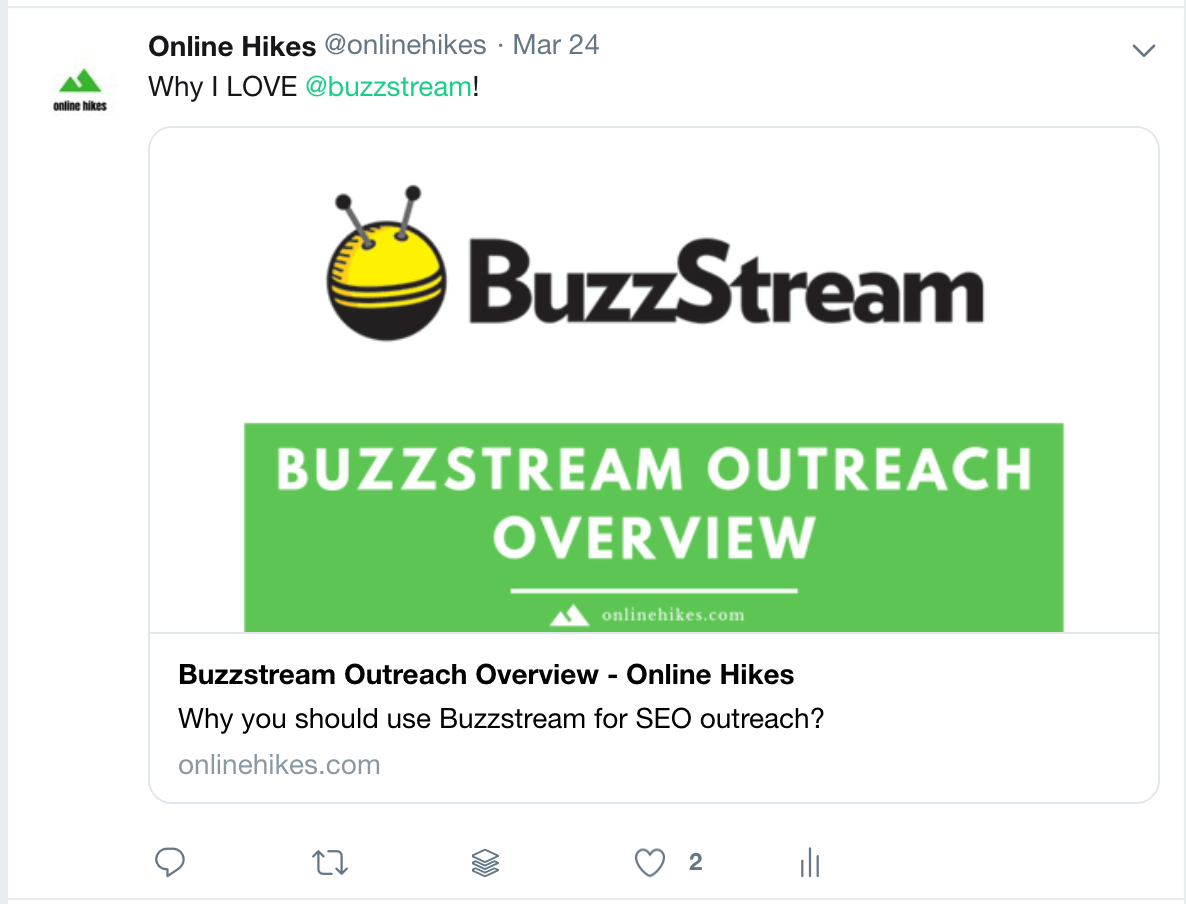
Or send a direct message.
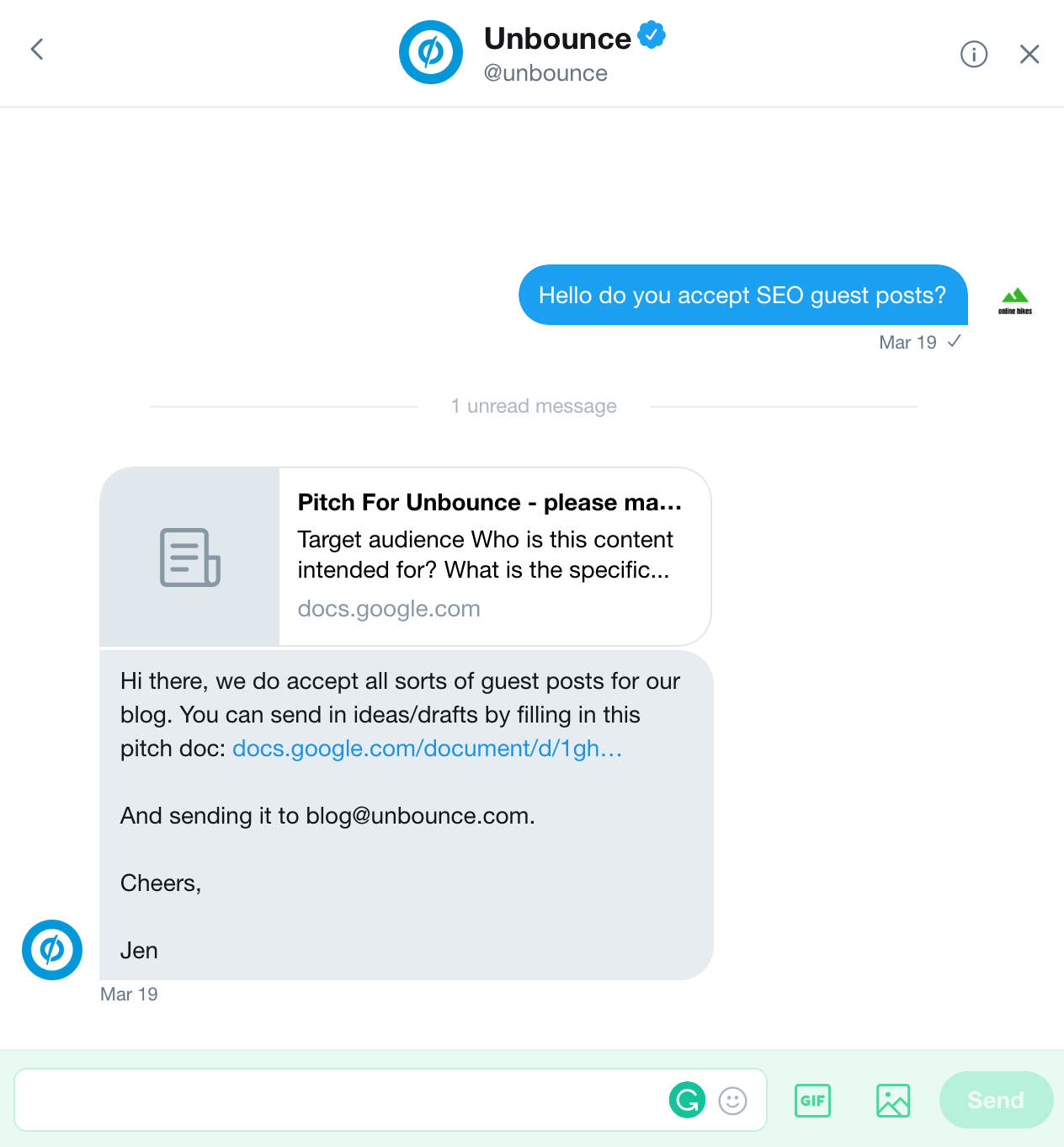
You can also @mention key influencers when publishing a new blog.
What works for me on Facebook? I try to send messages to Pages (of some publications, brands, blogs) or bloggers, asking for a guest post, backlink or social media share.

Of course, Facebook groups also work well. Join related Facebook groups and amplify your content there. Join guest posting, blogging, link building groups and reach out to people.
Research key influencers in your niche on Instagram. Of course, many of them will be super expensive. But, try to offer some value to them first. Ask for a guest post opportunity – not on Instagram, on their web blog.
Linkedin is #1 network for B2B. You can automate Linkedin outreach with tools like Dux Soup.
Other social media
You should figure out, which social media works better in your niche. Youtube, Reddit, Pinterest can be sources of massive traffic and backlink or outreach opportunities. So, test these mediums and find out what works for your blog.
Contact forms
If there is no email, I highly recommend trying outreach via contact forms.
There is a much higher response rate via contact forms, compared to emails.
Outreach via comments
Try to leave good quality comments on relevant sites – at least 2-3 paragraphs, related to the content of the blog post.
In the last part of the comment ask for a cooperation opportunity.
Summing it up
I create backlinks in many ways for my project: directories, listings, customers, press releases, etc. But, outreach is the main source of high-quality backlinks for me.
Outreach doesn’t bring immediate traffic (as Facebook does), but good quality backlinks from outreach will create steady evergreen traffic from Google in several months.
So, it is worth investing time and money, if you are serious about your SEO and want to scale your projects.
Back to you
Does outreach work for you? Which tools do you use? Leave suggestions in comments below.
Become a better marketer with Online Hikes membership. Start for free!
